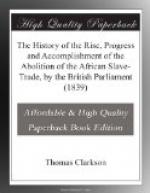The figure from B to D represents the third class, or that of the Quakers in America when joined with others in 1774. The stream passing from D through E to X shows how this class was conveyed down, as it were, so as to unite with the second. That passing from D to Y shows its course in its own country, to its enlargement in 1787. And here I may observe, that as the different streams which formed a junction at X, were instrumental in producing the abolition of the Slave Trade in England, in the month of March, 1807, so those, whose effects are found united at Y, contributed to produce the same event in America, in the same month of the same year.
The figure from F to X represents the fourth class up to 1787.
[Illustration: First Class of Forerunners and Coadjutors]
[Illustration: Second Class of Forerunners and Coadjutors]
[Illustration: Third Class of Forerunners and Coadjutors]
X represents the junction of all the four classes in the committee instituted in London on the twenty-second day of May, 1787.
The parallel lines G, H, I, K, represent different periods of time, showing when the forerunners and coadjutors lived. The space between G and H includes the space of fifty years, in which we find but few labourers in this cause. That between H and I includes the same portion of time, in which we find them considerably increased, or nearly doubled. That between I and K represents the next thirty-seven years; but here we find their increase beyond all expectation, for we find four times more labourers in this short term, than in the whole of the preceding century.
In looking over the map, as thus explained, a number of thoughts suggested themselves, some of which it may not be improper to detail. And first, in looking between the first and second parallel, we perceive, that Morgan Godwyn, Richard Baxter, and George Fox, the first a clergyman of the established church, the second a divine at the head of the nonconformists, and the third the founder of the religious society of the Quakers, appeared each of them the first in his own class, and all of them, about the same time, in behalf of the oppressed Africans. We see then this great truth first apparent, that the abolition of the Slave Trade took its rise, not from persons who set up a cry for liberty, when they were oppressors themselves, nor from persons who were led to it by ambition, or a love of reputation among men, but where it was most desirable, namely, from the teachers of Christianity in those times.
This account of its rise will furnish us with some important lessons. And first, it shows us the great value of religion. We see, when moral disorders become known, that the virtuous are they who rise up for the removal of them. Thus Providence seems to have appointed those who devote themselves most to his service, to the honourable office of becoming so many agents, under his influence, for the correction




